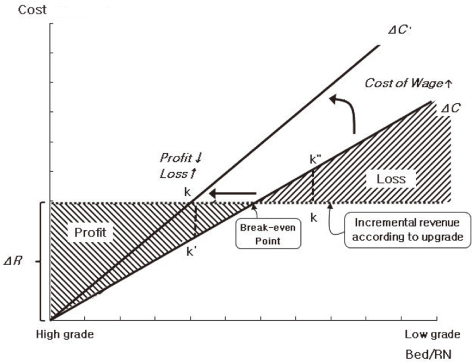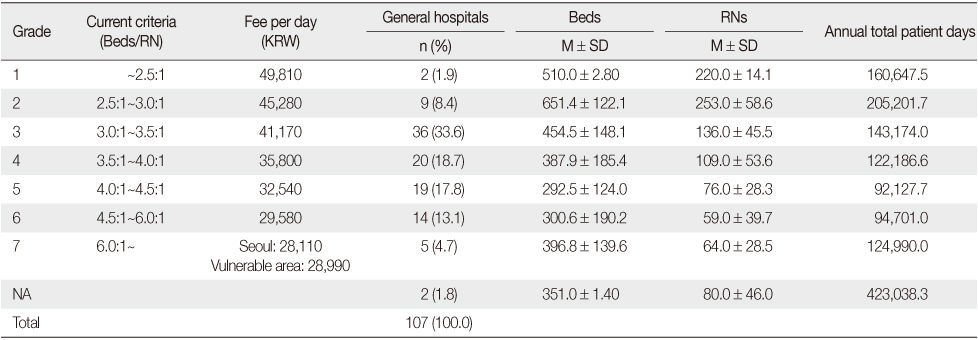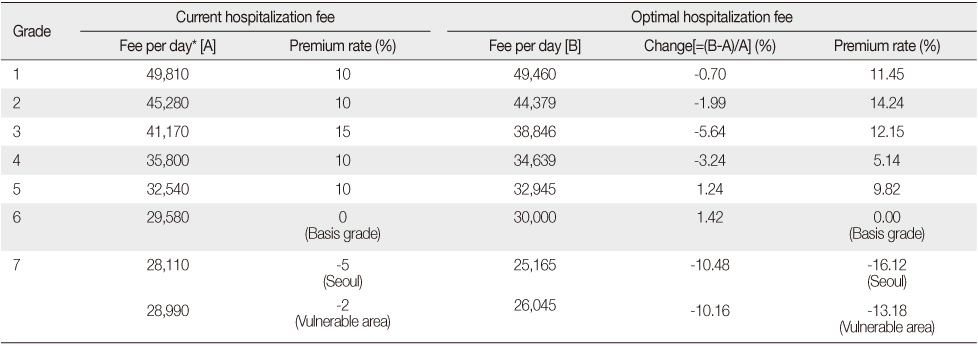Articles
- Page Path
- HOME > J Korean Acad Nurs > Volume 42(3); 2012 > Article
-
Original Article
- A Proposal to Improve Nursing Fee Differentiation Policy for General Hospitals Using Profitability-Analysis in the National Health Insurance
- Sungjae Kim, Jinhyun Kim
-
Journal of Korean Academy of Nursing 2012;42(3):351-360.
DOI: https://doi.org/10.4040/jkan.2012.42.3.351
Published online: June 29, 2012
1Doctoral Student, Department of Nursing, Seoul National University & Research Worker, The Research Institute of Nursing Science, Seoul, Republic of Korea.
2Associate professor, Department of Nursing, Seoul National University & Research Worker, The Research Institute of Nursing Science, Seoul, Republic of Korea.
- Address reprint requests to: Kim, Jinhyun. College of Nursing, Seoul National University, 28 Yeongeon-dong, Jongro-gu, Seoul 110-744, Republic of Korea. Tel: +82-11-590-7582, Fax: +82-2-747-3948, jinhyun@snu.ac.kr
© 2012 Korean Society of Nursing Science
Abstract
-
Purpose
- The purpose of this study was to propose optimal hospitalization fees for nurse staffing levels and to improve the current nursing fee policy.
-
Methods
- A break-even analysis was used to evaluate the impact of a nursing fee policy on hospital's financial performance. Variables considered included the number of beds, bed occupancy rate, annual total patient days, hospitalization fees for nurse staffing levels, the initial annual nurses' salary, and the ratio of overhead costs to nursing labor costs. Data were collected as secondary data from annual reports of the Hospital Nursing Association and national health insurance.
-
Results
- The hospitalization fees according to nurse staffing levels in general hospitals are required to sustain or decrease in grades 1, 2, 3, 4, and 7, and increase in grades 5 and 6. It is suggested that the range between grade 2 and 3 be sustained at the current level, the range between grade 4 and 5 be widen or merged into one, and the range between grade 6 and 7 be divided into several grades.
-
Conclusion
- Readjusting hospitalization fees for nurse staffing level will improve nurse-patient ratio and enhance the quality of nursing care in hospitals. Follow-up studies including tertiary hospitals and small hospitals are recommended.
- 1. Aiken LH, Clarke SP, Cheung RB, Sloane DM, Silber JH. Educational levels of hospital nurses and surgical patient mortality. Journal of the American Medical Association. 2003;290:1617–1623. http://dx.doi.org/10.1001/jama.290.12.1617.ArticlePubMed
- 2. Aiken LH, Sloane DM, Cimiotti JP, Clarke SP, Flynn L, Seago JA, et al. Implications of the California nurse staffing mandate for other states. Health Services Research. 2010;45:904–921. http://dx.doi.org/10.1111/j.1475-6773.2010.01114.x.ArticlePubMedPMC
- 3. Chae G, Kim K, Park M, Jeong J, Choi H. The hospital nurse's actual working conditions research: Annual report of hospital nurses association in 2009. 2009;Seoul, Seoul Hospital Nurses Association. 175–216.
- 4. Cho S, June KJ, Kim YM, Park BH. Changes in hospital nurse staffing after implementing differentiated inpatient nursing fees by staffing grades. Journal of Korean Academy of Nursing Administration. 2008;14:167–175.
- 5. Cho S, Ketefian S, Barkauskas VH, Smith DG. The effects of nurse staffing on adverse events, morbidity, mortality and medical costs. Nursing Research. 2003;52:71–79. http://dx.doi.org/10.1097/00006199-200303000-00003.ArticlePubMed
- 6. Cho S, Lee H, Oh J, Kim J. Inpatient outcomes by nurse staffing grade in Korea. Korean Journal of Health Policy and Administration. 2011;21:195–212. http://dx.doi.org/10.4332/KJHPA.2011.21.2.195.Article
- 7. Cho SY, Park JH. Development of a nursing fee schedule model. The Journal of Nurses Academic Society. 1993;23:68–89.ArticlePDF
- 8. Estabrooks CA, Midodzi WK, Cummings GG, Ricker KL, Giovannetti P. The impact of hospital nursing characteristics on 30-day mortality. Nursing Research. 2005;54:74–84. http://dx.doi.org/10.1097/00006199-200503000-00002.PubMed
- 9. Health Insurance Review & Assessment Service. Health insurance medical expenditure in 2009. 2009;Seoul, Author.
- 10. Jang Y. Health statistics. 2004;1st ed. Seoul, MJ media.
- 11. Kim J, Kim S, Park B. Alternative strategies of nursing fees differentiation policy in the national health insurance. 2011;Seoul, Seoul National University & Korean Nurses Association.
- 12. Kim J, Park S, Kim M, Sung Y, Park K, Kim S, et al. The effect of nursing grades on a hospital's financial performance in nursing fees differentiation policy. 2009;Seoul, Seoul Nurses Association.
- 13. Kim J. Job satisfaction and patient satisfaction related to nurse staffing. Journal of Korean Academy of Nursing Administration. 2007;13:98–108.
- 14. Ko YK, Kim BJ. An analysis of nurse staffing level and nursing performance in the general unit. Journal of Korean Academy of Nursing Administration. 2008;14:413–420.
- 15. Marcell S, Ernst T, Gerald HL. Break-even analyses: Basic model, variants, extensions. 1992;1st ed. New York, NY, John Wiley & Sons.
- 16. Mark BA, Harless DW, McCue M, Xu Y. A longitudinal examination of hospital registered nurse staffing and quality of care. Health Services Research. 2004;39:279–300. http://dx.doi.org/10.1111/j.1475-6773.2004.00228.x.ArticlePubMedPMC
- 17. McGillis Hall L, Doran D, Pink GH. Nurse staffing models, nursing hours, and patient safety outcomes. Journal of Nursing Administration. 2004;34:41–45.ArticlePubMed
- 18. Ministry of Health & Welfare. Notification No. 2006-106 of the Ministry of Health & Welfare. 2006;12 18 Retrieved May 19, 2010. from http://www.mw.go.kr/front/jb/sjb0401ls.jsp?PAR_MENU_ID=03&MENU_ID=030401.
- 19. Ministry of Health & Welfare. Notification No. 2010-8 of the Ministry of Health & Welfare. 2010;01 13 Retrieved May 19, 2010. from http://www.mw.go.kr/front/jb/sjb0401ls.jsp?PAR_MENU_ID=03&MENU_ID=030401.
- 20. O D, Lee Y. The study of conversion factor for health insurance contracts for 2010. 2009;Seoul, Korean Hospital Association.
- 21. Park J, Hwangbo S, Lee E. Identification of nursing activities for determination of cursing cost. The Journal of Nurses Academic Society. 1992;22:185–206.
- 22. Park S. Analysis of direct nursing activity and patient outcomes related to graded fee of nursing management for inpatient. Journal of Korean Academy of Nursing. 2003;33:122–129.ArticlePubMedPDF
- 23. Ryu H, Jung K, Lim J. Test on the cost and development on the payment system of home health care nursing. Journal of Korean Academy of Nursing. 2006;36:503–513.ArticlePubMedPDF
- 24. Sohn I, Kwon J, Park D, Cho S, Han Y. Survey of hospital nurse's wages: Annual report of hospital nurses association in 2009. 2009;Seoul, Seoul Hospital Nurses Association. 157–178.
- 25. The National Assembly of the Republic Korea. Chapter 3 clause 3 of the Korean medical law. 2010;Retrieved May 15, 2010. from http://likms.assembly.go.kr/law/jsp/Law.jsp?WORK_TYPE=LAW_BON&LAW_CHECK=TRUE&LAW_ID=A1549&PROM_NO=10387&PROM_DT=20100723&SRCHK=Y.
REFERENCES
Figure & Data
REFERENCES
Citations

- Changes in Nursing Grades and Nurse Staffing Levels following the 2024 Revision of Nursing Management Fee Standards: A Focus on Tertiary Hospitals and Medical Institutions in Seoul
Hyeyoung Choi, Kiyoung Kim, Su-Jin Cho, Suyong Jeong
Health Insurance Review & Assessment Service Research.2025; 5(1): 58. CrossRef - Impact evaluation of nurse staffing policy reform in Korea: A quasi‐experimental study
Jinseon Yi, Jinhyun Kim
Journal of Nursing Management.2022; 30(7): 3457. CrossRef - Improvement Plan of Nurse Staffing Standards in Korea
Sujin Shin, Jong Duck Park, Juh Hyun Shin
Asian Nursing Research.2020; 14(2): 57. CrossRef - An Empirical Analysis of Costs related to Nursing Practice
Yu Kyung Ko, Bo-Hyun Park
Journal of Korean Academy of Nursing Administration.2017; 23(2): 139. CrossRef - Study on Factors Associated with the Rise in Grade of Nursing Management Fee among Korean Hospitals
Hyun-Min Choi, Nam-Kyung Han, Sang-Kyu Lee, Han-Sung Kim, Sungkyoung Choi, Woojin Chung
Health Policy and Management.2015; 25(1): 40. CrossRef - Financial Projection of the Nursing Fee Differentiation Policy Improvement Proposal in the National Health Insurance: Using a Break-even Analysis Model for the Optimal Nursing Fee
Sungjae Kim, Jinhyun Kim
Journal of Korean Academy of Nursing Administration.2013; 19(5): 565. CrossRef

Figure 1
The Number of General Hospitals, Beds, RNs and Annual Total Patient Days
Data from health insurance medical expenditure in 2009 (Health Insurance Review & Assessment Service, 2009); Data from Hospital Nurses Association in 2009 (Chae et al., 2009).
KRW=Korea Won; RN=Registered nurse.
*Annual total patient days=beds×utilization rate×365.
Break-even Points of Beds-to-RN and Bed Occupancy Rate for Corresponding Grades (Unit: ratio, %)
Optimal Hospitalization Fees for Nurse Staffing Levels in General Hospitals (Unit: won)
*Fee per day=Hospitalization fee per a day=medical management fee(40%)+nursing management fee(25%)+hospital management fee (35%).
Data from health insurance medical expenditure in 2009 (Health Insurance Review & Assessment Service, 2009); Data from Hospital Nurses Association in 2009 (Chae et al., 2009). KRW=Korea Won; RN=Registered nurse. *Annual total patient days=beds×utilization rate×365.
*Fee per day=Hospitalization fee per a day=medical management fee(40%)+nursing management fee(25%)+hospital management fee (35%).
 KSNS
KSNS
 E-SUBMISSION
E-SUBMISSION




 Cite
Cite

